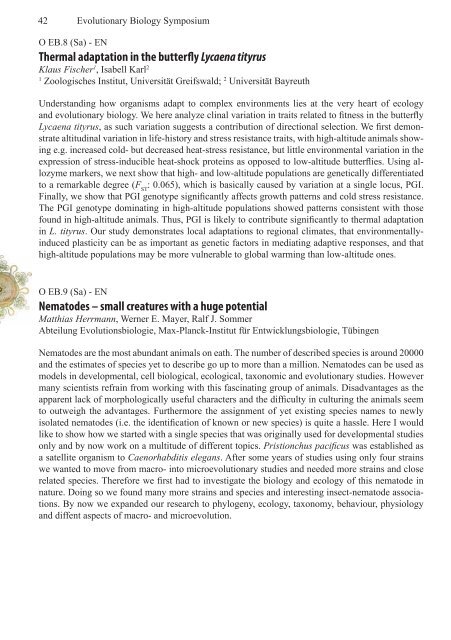Abstracts - Deutsche Zoologische Gesellschaft
Abstracts - Deutsche Zoologische Gesellschaft
Abstracts - Deutsche Zoologische Gesellschaft
You also want an ePaper? Increase the reach of your titles
YUMPU automatically turns print PDFs into web optimized ePapers that Google loves.
42 Evolutionary Biology SymposiumO EB.8 (Sa) - ENThermal adaptation in the butterfly Lycaena tityrusKlaus Fischer 1 , Isabell Karl 21<strong>Zoologische</strong>s Institut, Universität Greifswald; 2 Universität BayreuthUnderstanding how organisms adapt to complex environments lies at the very heart of ecologyand evolutionary biology. We here analyze clinal variation in traits related to fitness in the butterflyLycaena tityrus, as such variation suggests a contribution of directional selection. We first demonstratealtitudinal variation in life-history and stress resistance traits, with high-altitude animals showinge.g. increased cold- but decreased heat-stress resistance, but little environmental variation in theexpression of stress-inducible heat-shock proteins as opposed to low-altitude butterflies. Using allozymemarkers, we next show that high- and low-altitude populations are genetically differentiatedto a remarkable degree (F ST: 0.065), which is basically caused by variation at a single locus, PGI.Finally, we show that PGI genotype significantly affects growth patterns and cold stress resistance.The PGI genotype dominating in high-altitude populations showed patterns consistent with thosefound in high-altitude animals. Thus, PGI is likely to contribute significantly to thermal adaptationin L. tityrus. Our study demonstrates local adaptations to regional climates, that environmentallyinducedplasticity can be as important as genetic factors in mediating adaptive responses, and thathigh-altitude populations may be more vulnerable to global warming than low-altitude ones.O EB.9 (Sa) - ENNematodes – small creatures with a huge potentialMatthias Herrmann, Werner E. Mayer, Ralf J. SommerAbteilung Evolutionsbiologie, Max-Planck-Institut für Entwicklungsbiologie, TübingenNematodes are the most abundant animals on eath. The number of described species is around 20000and the estimates of species yet to describe go up to more than a million. Nematodes can be used asmodels in developmental, cell biological, ecological, taxonomic and evolutionary studies. Howevermany scientists refrain from working with this fascinating group of animals. Disadvantages as theapparent lack of morphologically useful characters and the difficulty in culturing the animals seemto outweigh the advantages. Furthermore the assignment of yet existing species names to newlyisolated nematodes (i.e. the identification of known or new species) is quite a hassle. Here I wouldlike to show how we started with a single species that was originally used for developmental studiesonly and by now work on a multitude of different topics. Pristionchus pacificus was established asa satellite organism to Caenorhabditis elegans. After some years of studies using only four strainswe wanted to move from macro- into microevolutionary studies and needed more strains and closerelated species. Therefore we first had to investigate the biology and ecology of this nematode innature. Doing so we found many more strains and species and interesting insect-nematode associations.By now we expanded our research to phylogeny, ecology, taxonomy, behaviour, physiologyand diffent aspects of macro- and microevolution.

















